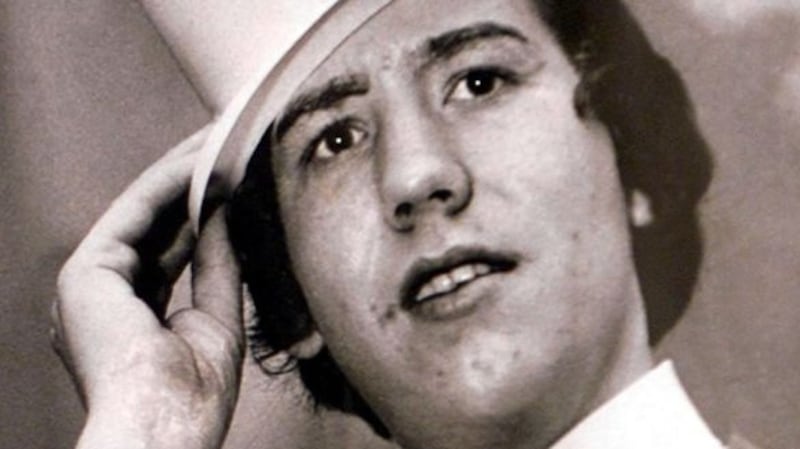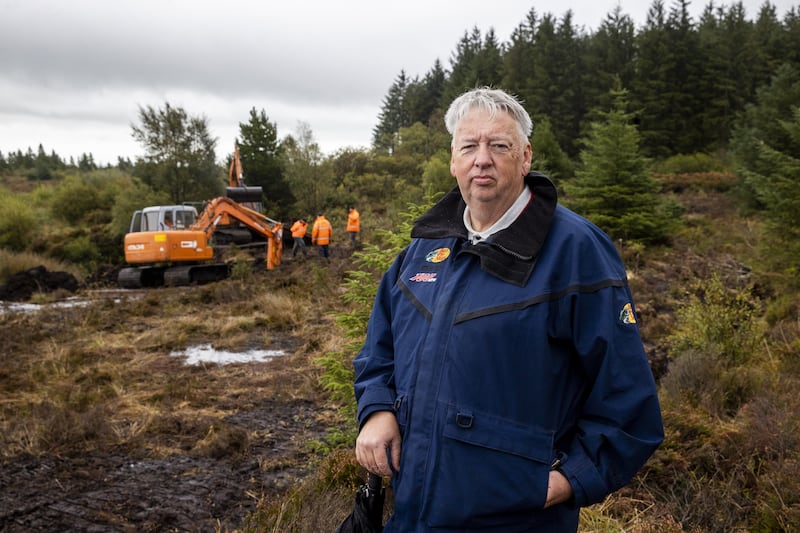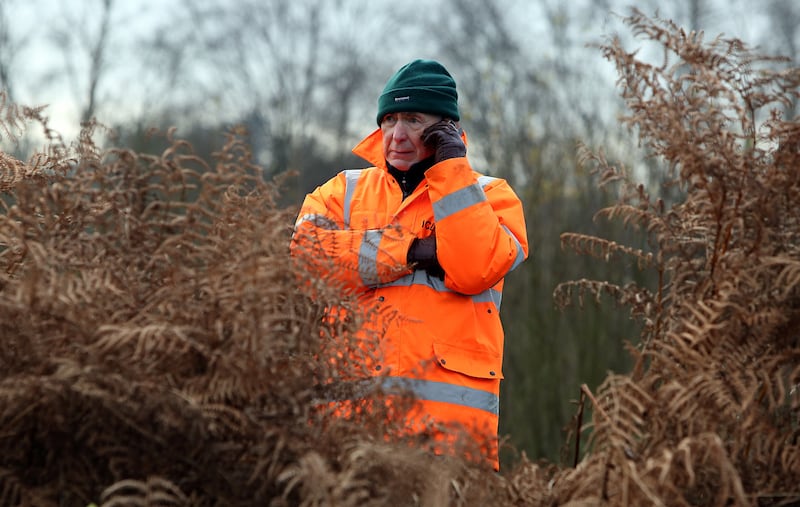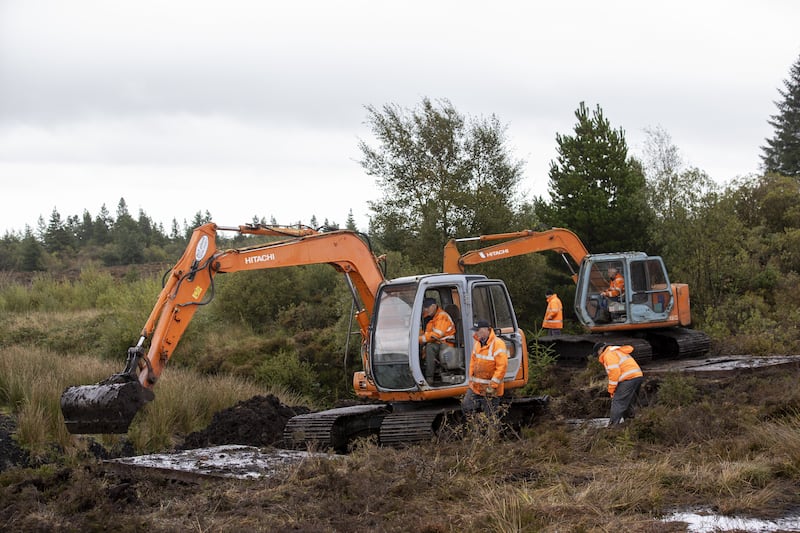The bumpy potholed track through bog and forest leading to the spot where the search for Columba McVeigh’s remains is taking place is a mile long but it seems to go on for an eternity.
Anyone doing the painfully slow drive must wonder at the terror the 19-year-old surely endured as he was driven through this bleak landscape on November 2nd, 1975.
Long before she had the stomach to visit Bragan Bog near the Monaghan/Tyrone border, Columba’s sister Dympna Kerr revealed that she had a picture she could not get out of her mind.
“I have an image in my head of Columba standing there crying, looking into a hole,” she told a journalist.
His brother, Oliver, who was just 13 when Columba disappeared, remembers him as “a happy go lucky sort of bloke, full of devilment, always playing wee tricks”. He believes Columba was shot on the bog before being buried.

Nobody knows what condition the teenager, who according to his brother was “not the sharpest cookie in the jar”, was in as he was taken to this desolate spot after being “interrogated” elsewhere.
The Independent Commission for the Location of Victims’ Remains (ICLVR) returned to Bragan Bog on October 3rd for a sixth search of the area, It is now focusing on a two acre site after getting “more refined detail”, according to Geoff Knupfer, the lead forensic investigator.
The former Manchester detective, who in the 1980s led the search for victims of Moors murderers Ian Brady and Myra Hindley, accepts that conditions at Bragan are “challenging” as fog and relentless rain seem to chime with the horror of his crew’s task.
Two large excavators are painstakingly turning over a few centimetres of soil at a time, under the watchful eyes of a pair of forensic archaeologists.
“It is like standing on a blancmange at the present time. It looks like glue,” says Knupfer, pointing out the steel mats the machines rest on while turning the peat in order to prevent them sinking.
The former police man turned academic explains that the archeologists at Bragan are not just looking for a body, but are on the lookout for any anomalies in the soil which would tell them if it had ever been disturbed.
Oliver McVeigh says his family has always regarded November 2nd, All Souls Day, as Columba’s anniversary as he was abducted on November 1st ‘and we assume he was interrogated for a day’
“They can tell if it is pristine or spoiled,” says Knupfer, who points out that they were looking not just for skeletal remains.
“We often get clothing as well. And footwear. It is grim.”
Mostly the small crew — digger drivers, archaeologists, Knupfer and other experts — are left alone as they get on with their painstaking task, but they are on nodding terms with local people cutting turf in the area and also with personnel from Coillte.
In recent weeks the Catholic Archbishop of Armagh Eamon Martin paid a low-key visit accompanied by Fr Joe Gormley, the Derry-based cleric who anointed the murdered journalist Lyra McKee after she was shot in the city during rioting in 2019.
In his homily during a Mass for the Disappeared last Easter, Archbishop Martin said there were 19 known cases of individuals abducted, murdered and secretly buried during the Troubles “but in likelihood there are others”.
Fr Gormley has composed a prayer for the return of The Disappeared which will be published on November 2nd, during the annual silent walk undertaken by the families at Stormont.
Oliver McVeigh says his family has always regarded November 2nd, All Souls Day, as Columba’s anniversary as he was abducted on November 1st “and we assume he was interrogated for a day”.

A photojournalist, he is “hopeful” that this sixth search will uncover his brother’s body. Sadly this would be too late for his mother, Vera, who until 1999, when the IRA admitted having been responsible for the forced disappearance of nine people including Columba, believed he would come home. Oliver says that when the first search started in 1999, Vera thought Columba would be found within a week or a fortnight.
“She was happy at the fact that she was going to get him back. She used to go up armed with boxes of buns and biscuits and cigarettes because she was highly appreciative of the men who were working there,” he says. “She was always saying ‘youse are doing a great job’. She was never in doubt. Can you imagine how downtrodden she must have felt when it finished?”
Oliver says the same handful of men are mostly still involved in the search for his brother. When his mother died in 2007 aged 82, they turned up at her wake and funeral. “And they were tearful. They hadn’t found him and she was gone. It was a huge disappointment to them also.”
Knupfer is also hopeful that this search of two acres will yield the result that the family has yearned for, despite the fact that more than 20 acres of Bragan Bog have already been combed to no avail.
He believes the ICLVR has the trust of the republican movement because nobody has ever been questioned or prosecuted as a result of information provided to it.

“I think there is a naivety that people think they are just holding out on some of this stuff,” he says. “But you have to remember this is nearly 50 years ago and a lot of the people who were involved are dead, and others are either relying on people who knew about it, who weren’t personally involved, or occasionally were personally involved.”
He said some people assumed it was a case of saying “‘it’s over there’, and it actually doesn’t work like that”.
Knupfer, who in 2005 was asked by the Irish and British governments to do a review of the work done by the ICLVR since 1999, before ultimately being asked to take a lead role, says a body has been recovered exactly in the spot identified to the commission in only one case since then.
“I think only in one case they got it absolutely right,” he says. “In all the other ones, they have been out by a little or a lot. In one of them we were out by probably half a mile. And there is no intention to mislead us. That was genuine belief that that was where the grave was.”
The forensic scientist, who interviewed Ian Brady and Myra Hindley, says he himself found it hard to get his bearings when he returned recently to Saddleworth Moor where he and colleagues in the 1980s discovered the body of 16-year-old Pauline Reade, two decades after her murder.
“I knew it backwards because we worked so much up there on Saddleworth Moor. And I went back and was hard pressed to get my precise bearings,” he says.
“So we don’t underestimate the difficulties. And you can see that if someone is going to come up here in the middle of the night and murder somebody and bury the body, asking them to come back 50 years later and say whereabouts was it, is a very tall order indeed.”
He believes Hindley, who he worked closely with on the Moors investigation before her death in 2002, did try to be helpful in the search for the bodies of the murdered children, but says Brady was “a complete psycho, really”.
There is no intention whatever to mislead. We are as happy as we can be that we are in the right place. But there is always this doubt
Describing Hindley as “a woman on a mission”, he suspects she had been advised that if she “spilt the beans” she would have a better chance of getting parole. “I think her motivation was all about getting out but I actually got on well with her. She was okay.”
He says a question often asked of those doing the work he does, is how they engage with people knowing what they have done.
“You are not befriending people but you are certainly engaging with them and trying to resolve an issue. If you just stand off you wouldn’t get anywhere,” Knupfer says.
Asked what motivates people who provide information to the ICLVR, and whether he believes it is remorse or guilt, he replies: “We have certainly encountered that, people who are remorseful and are looking for a way to resolve it before they die”.
Parts of Bragan Bog are heavily forested but the search team believes that when Columba McVeigh was murdered, there were no trees, or at most rows of tiny saplings.

Knupfer says the plantations have transformed the bog, but points out that after five previous searches, hundreds of trees have been cut down.
The current search is divided into phases A and B, the first of which they hope to complete before the longer nights force them to stall the search until the spring.
“We are fighting against the weather all the time. Ground conditions are atrocious,” says Knupfer. “And there are health and safety concerns, worries about diggers falling into a trench, all sorts of issues. And of course the days are getting shorter. It is a race against time. We are hoping we can complete A before Christmas, but we will get rained off before the end of November almost certainly”.
If Columba McVeigh’s remains are not returned to his family in phase A, there are plans to remove several trees in the other wooded part of the search site.
“Before we start searching B, the trees will be cut one by one. We will have archaeologists supervising it so that nothing is damaged,” he adds. “We will take the roots out literally one by one and the archaeologists will watch the roots coming out.”
His final words to his mother, who would for years watch out for another letter, were: “I will say bye for now’
Will they be successful in getting the result the McVeigh family has hoped for since the IRA confirmed in 1999 that Columba would not, as his mother always hoped, “come home, married, with a handful of grandchildren for me to look after”?
“I would like to think so,” says Knupfer. “I mean we’re absolutely 100 per cent certain that Columba McVeigh was buried here. Now it is hard to say what could have happened in the intervening period.
“We are as happy as we can be that the people who are telling us where he is, are honest, truthful, well-intentioned and probably know or have been told. So there is no intention whatever to mislead. We are as happy as we can be that we are in the right place. But there is always this doubt.”
Does he think the body could have been moved?

“Well that is also a possibility and it is not one we discount by any means. But you have got to say why would someone do that”.
Oliver McVeigh has no problem with the immunity from prosecution granted to anyone providing information to the ICLVR. “I just want the body back,” he says. But if Columba is not found, he believes there should be no immunity for anyone found to have not co-operated with the commission.
He is also critical of the response of the Sinn Féin leadership, believing the search for the Disappeared “is not high up on their agenda”.
“Sinn Féin, like it or lump it, is inextricably linked to the Provisional IRA. I am convinced there are still little snippets of information that could be got to help find his body and the others,” he says. “There is an ardfheis every year and let’s be honest, the ardfheis is full of former combatants. But it is never mentioned.”
McVeigh said that while the republican movement holds solemn and respectful commemorations for its own dead, “I don’t have a grave to go to”. Citing party leaders Mary Lou McDonald and Michelle O’Neill in particular, he says he believes they could and should put more pressure on people who have information.
Responding to his criticism, a Sinn Féin spokesman said the party had called for the establishment of the ICLVR. “Sinn Féin has consistently called on anyone with information that could help lead to the retrieval of bodies in the outstanding cases, including Columba McVeigh, to come forward to the commission.”
Columba McVeigh’s name is on the back of the headstone where his parents Vera and Paddy are buried, and his siblings Oliver, Dympna and Eugene want nothing more than to lay him to rest there.
“She always said she would be happy to die and go to her grave if he was there and me dad,” says Oliver.
“He was the apple of her eye,” he goes on, explaining that for years after Columba disappeared Vera continued to buy him Christmas and birthday presents. “You’d see wee things lying about wrapped up.”
Oliver also recalls a picture that his mother had in her livingroom which no one was allowed to take down.
“She used to say ‘Columba bought that for me’. It was like a street scene, from way back, a CS Lewis sort of thing. It wasn’t what it was, it was the fact that he bought it. She got it framed maybe twice.”
Oliver also has a letter written by Columba from Dublin to his mother a few weeks before he was abducted, in which he described having witnessed the funeral of Éamon de Valera.
“Even I felt sad when I seen the people crying and weeping in the street,” the teenager wrote.
After asking after his father and his brother, Columba expressed concern about the increasing political tension around his native Donaghmore, asking: “What about yourself? I hear things are rough up there”, before urging Vera to write back soon “and tell me all the news”.
His final words to his mother, who would for years watch out for another letter, were: “I will say bye for now. God bless and take care. From your big son, Columba”.
The ICLVR is seeking information on four outstanding cases: Joe Lynskey, Columba McVeigh, Robert Nairac and Seamus Maguire. The commission says its only desire is to bring the remains of loved ones home to their families so they can be given a Christian burial. “But we need help to do that”.
The ICLVR can be contacted by telephone: 00 800 5558 5500 and internationally on 00 353 1 602 8655.






